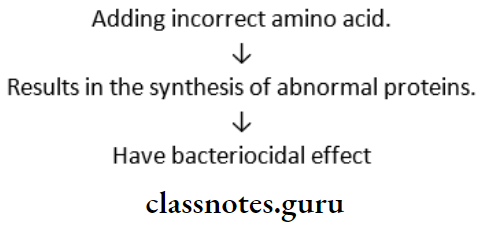Aminoglycosides Important Notes
1. Aminoglycosides
- They contain amino carbohydrate complexes with glycoside bonding
- Drug of choice for gram-negative infection
- Acts by blocking mRNA
- Aminoglycosides Examples
- Streptomycin
- Kanamycin
- Amikacin
- Gentamycin
- Netilmycin
- Aminoglycosides Adverse effects
- Ototoxicity
- Nephrotoxicity
- Neuromuscular blockade
- Topically used aminoglycosides
- Neomycin
- Gentamycin
Read And Learn More: Pharmacology Question and Answers
Aminoglycosides Long Essays
Question 1. Enumerate aminoglycoside antibiotics. Write antibacterial spectrum mechanism of action uses and adverse effects of gentamicin.
Answer:
Aminoglycosides:
Aminoglycosides are a group of natural and semisynthetic antibiotics having polybasic amino groups linked glycosidically to two or more.
Aminoglycosides Classification:
1. Systemic aminoglycosides
Streptomycin, gentamicin, kanamycin, tobramycin, amikacin, netilmicin.
2. Topical aminoglycosides
Neomycin, framycetin.
Gentamicin:
- It is obtained from micromonospora purpurea.
- It is a commonly used aminoglycoside.
- It is more potent
Gentamicin Anti-bacteial spectrum:
- It has a broader spectrum of activity.
- Effective against P.aeruginosa and most strains of proteus, E-coli, klebsiella, enterobacter, and Serratia.
- Inhibits strep. Faecalis and some staph. Aureus.
Aminoglycosides pharmacology
Anti-bacterial spectrum Mechanism of action:

- Blocking initiation of protein synthesis by
- Terminating protein synthesis.

Gentamicin Uses:
1. In dentistry
Gentamicin 2 mg/kg IM/IV single dose is given to supplement amoxicillin or vancomycin for prophylaxis of bacterial endocarditis.
2. General medical uses
- Urinary tract infections.
- Pneumonia – used along with penicillin.
- Used in preventing and treating. Respiratory infections in critically ill patients.
- Osteomyelitis, peritonitis, septicaemia.
- Bacterial endocarditis – used in place of streptomycin.
- Topical uses.
- As cream – in bums and infected wounds.
- As eye drops – in conjunctivitis.
Gentamicin Adverse effects:
1. Ototoxicity
- The vestibular or cochlear part may be primarily affected.
- Sensory cells present undergo destructive changes.
- Tinnitus appears first, followed by deafness.
- Vestibular dysfunction is characterized by headache, nausea, vomiting, dizziness, vertigo, nystagmus and ataxia.
2. Nephrotoxicity
- Manifests as tubular damage resulting in loss of urinary concentrating power, low GFR, nitrogen retention, and albuminuria.
- Effects are reversible.
3. Neuromuscular blockade
Aminoglycosides reduce acetylcholine release from motor nerve endings.
Aminoglycosides Short Essays
Question 1. Neomycin.
Answer:
It is a topical aminoglycoside.
It is a wide-spectrum aminoglycoside.
Neomycin Uses:
1. Topical use
Used for infected wounds, ulcers, burns, external ear infections, and conjunctivitis.
2. Oral use
- Preparation of bowel before surgery.
- Hepatic coma.
Neomycin Adverse effects:
- Highly ototoxic.
- Oral use causes diarrhoea, steatorrhea and malabsorption syndrome.
- Skin rashes on topical use.
Aminoglycosides side effects
Aminoglycosides Short Question And Answers
Question 1. Aminoglycoside.
Answer:
Aminoglycoside Classification:
1. Systemic aminoglycosides
Streptomycin, gentamicin, konamydn, amikacin.
2. Topical aminoglycosides
Neomycin, framycetin.
Aminoglycoside Properties:
- They are not absorbed orally.
- All are sulphate salts.
- Highly water soluble.
- Distribute only extracellularly.
- Do not penetrate CSF.
- Excreted unchanged by the kidneys.
- All are bacteriocidal.
- Act by inhibiting bacterial protein synthesis.
- They are more active at alkaline pH.
- All are active primarily against aerobic gram-negative bacilli.
- There is partial cross-resistance among them.
- Have a narrow margin of safety.
- Exhibit nephrotoxicity and ototoxicity.
Question 2. Streptomycin.
Answer:
Streptomycin is the oldest aminoglycoside.
- It is obtained from streptomyces griseus.
- It is not metabolized, so excreted unchanged in the urine.
- Plasma t½ -2-4hours.
Streptomycin Uses:
- Tuberculosis.
- Subacute bacterial endocarditis.
- Plague, tularaemia, brucellosis.
Streptomycin Adverse effects:
- Less nephrotoxic.
- Less ototoxic.
- Hypersensitivity reactions – rashes, eosinophilia, fever and exfoliative dermatitis.
- Pain at the site of injection.
- Rarely paresthesia occurs.
Aminoglycosides mechanism of action
Question 3. Gentamicin.
Answer:
Gentamicin Uses:
1. In dentistry
Gentamicin 2 mg/kg IM/IV single dose is given to supplement amoxicillin or vancomycin for prophylaxis of bacterial endocarditis.
2. General medical uses
- Urinary tract infections.
- Pneumonia – used along with penicillin.
- Used in preventing and treating. Respiratory infections in critically ill patients.
- Osteomyelitis, peritonitis, septicaemia.
- Bacterial endocarditis – used in place of streptomycin.
- Topical uses
- As cream – in burns and infected wounds.
- As eye drops – in conjunctivitis.
Gentamicin Adverse effects:
1. Ototoxicity
- The vestibular or cochlear part may be primarily affected.
- Sensory cells present undergo destructive changes.
- Tinnitus appears first, followed by deafness.
- Vestibular dysfunction is characterized by headache, nausea, vomiting, dizziness, vertigo, nystagmus and ataxia.
2. Nephrotoxicity
- Manifests as tubular damage resulting in loss of urinary concentrating power, low GFR, nitrogen retention, and albuminuria.
- Effects are reversible.
3. Neuromuscular blockade
Aminoglycosides reduce acetylcholine release from motor nerve endings
Aminoglycosides antibiotics
Question 4. Adverse effects of Aminoglycosides.
Answer:
1. Ototoxicity
- The vestibular or cochlear part may be primarily affected
- Sensory cells present undergo destructive changes
- Tinnitus appears first followed by deafness
- Vestibular dysfunction Is characterized by headaches. nausea, vomiting, dizziness, vertigo, nystagmus and ataxia
2. Nephrotoxicity
- Manifests as tubular damage resulting in loss of urinary concentrating power, low GFR, nitrogen retention, albuminuria
- Effects are reversible
3. Neuromuscular blockade
Aminoglycosides reduce acetylcholine release from motor nerve endings
